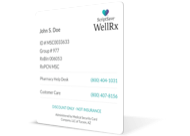Copyright 2024
Medical Security Card Company, LLC
All Rights Reserved
WellRx will never sell your personal information. Period. By signing up I agree to WellRx's terms of use and privacy policy.
By Jillian Foglesong Stabile, MD FAAFP
May 07, 2024
Coughing, sneezing, runny eyes, and sometimes even rashes are frustrating symptoms that may indicate an allergy. Allergies affect up to 20% of the global population, and their high prevalence results in significant direct and indirect socioeconomic burdens.
There are several types of allergies. Environmental factors such as pollen or pet dander and food allergies are the most common types, but there are many treatment options available.
An allergy is a type of immune response. When your body senses something it identifies as a threat, it produces antibodies. Antibodies are substances that trigger your immune system in response to that perceived threat. The immune response is appropriate if the threat is something like a virus or bacteria. But if the substance perceived as a threat is not actually a threat, like pet dander or pollen, the body's response is an overreaction.
An allergy can range from something benign yet annoying, like a runny nose, to something more serious, like a potentially life-threatening anaphylactic reaction. Most allergies can't be cured but can be treated to help minimize symptoms.
Many types of allergies can occur. The most common types for which people seek treatment are environmental, food, and medication allergies.
Environmental allergies affect around 24 million people in the United States. They frequently occur in response to pollen, molds, pet dander, dust mites, smoke, dust, and insects such as cockroaches. The most common symptoms associated with environmental allergies are congestion, runny nose, headache, and itchy, watery eyes. For some people, these allergies can trigger symptoms like an asthma attack. We'll discuss the symptoms associated with allergies in more detail later.
Food allergies may range in symptoms from mild to severe, just like any other allergy. Nausea, vomiting, stomach cramps, hives, shortness of breath, wheezing, dizziness, and anaphylaxis are just a few of the symptoms associated with food allergies. Eight foods make up about 90% of all allergic reactions:
In 2023, the FDA added sesame as a ninth major food allergen, requiring manufacturers to list it as an allergen in food products.
Medication or drug allergies can occur in response to both over-the-counter and prescription medications. The symptoms most commonly associated with this type of allergy are skin rashes or hives, itching, wheezing or breathing problems, swelling, and, in severe cases, anaphylaxis. The most common types of medications that cause drug allergies are penicillin and other antibiotics, sulfa-containing medications, anti-seizure medications, non-steroidal anti-inflammatory medications such as ibuprofen, aspirin or naproxen, and chemotherapy medications. If you suspect that you are having an allergic reaction to a medication, consult your healthcare provider immediately. Do not stop a medication without the direct guidance of your healthcare provider or other healthcare professional.
The symptoms of allergies vary from person to person. If you have an allergy to one allergen, your symptoms may be different from those of another potential allergen.
Allergic rhinitis generally presents as a runny nose or congestion. This type of allergic reaction is mediated by a type of antibody called immunoglobulin E. The symptoms usually occur seasonally, all year long, or episodically. Intermittent symptoms are usually defined as less than four days per week, while persistent symptoms are defined as more than four days per week and more than four weeks per year. Symptoms can vary in severity from mild symptoms that do not affect day-to-day life to severe symptoms that can impact quality of life as well as school and work performance.
Allergic conjunctivitis causes allergy symptoms that affect the eyes. There are several different subtypes of allergic conjunctivitis. In general, allergic conjunctivitis causes itching and eye discharge. The symptoms tend to primarily be associated with pregnant summer, but in some cases, they can happen year-round. Simple allergic conjunctivitis is estimated to affect 10 to 30% of the general population.
Asthma is a chronic lung condition that involves obstruction of the airways that limits expiratory flow. What this means is that you can get a full breath in, but you're not able to empty your lungs enough, which then makes it difficult to get additional air in. Estimates are that 7% of Americans have asthma. There's a strong correlation between asthma and conditions like eczema and allergies. Asthma is believed to be caused by a combination of genetic and environmental factors. However, all forms of asthma share the common factor: an exaggerated response to minor irritants. Symptoms of asthma include shortness of breath, wheezing, cough, and dizziness. Severe cases can lead to very limited air movement, which can be a medical emergency.
Hives and rashes can also occur in response to an allergen. Frequently, these are due to food allergens such as milk or eggs or a response to an infection or a medication. Eczema, also called atopic dermatitis, is one type of allergic rash. Contact dermatitis occurs in response to skin contact with an irritant or allergen. Hives are itchy red bumps that don't last very long most of the time. These can occur in response to oral or contact-type allergies. They generally last less than 24 hours but may become chronic as well.
Allergies can also affect the gastrointestinal tract. These allergies may range from eosinophilic esophagitis and eosinophilic gastritis to gastrointestinal anaphylaxis. Symptoms of allergies in the GI tract may include nausea, abdominal pain, cramping, vomiting, diarrhea, heartburn, and weight loss.
Anaphylaxis is one of the most serious types of allergic reactions. This is an acute life-threatening reaction that can cause shortness of breath, swelling, and throat closure. Anaphylaxis can occur even when you have not previously had an allergic reaction to something you've eaten or been exposed to before. The world population has a lifetime prevalence of anaphylaxis of between 1% and 3%, though this is believed to be increasing.
Allergies can be diagnosed in several different ways. Sometimes, allergies are diagnosed based on history and physical exam. If the source of the allergy isn't clear, your healthcare provider may offer testing to try to determine it. Allergy testing can be done through skin testing, blood testing, or both.
Skin testing is performed by a prick. A small amount of the possible allergen is exposed to the skin either under the skin by injection or through a prick or scratch on the skin. The healthcare provider then examines the skin to determine if there has been a response. This type of testing is generally done by an allergist, though other specialists may do the testing as well. Skin testing is primarily examining a histamine response.
Blood testing involves drawing blood and looking for elevated levels of IgE. IgE levels can be detected in response to specific allergens. The results of these tests are normally categorized based on the level of IgE present in the test period. This may or may not correspond with the level of symptoms that you are experiencing. Blood allergy testing is best interpreted under the guidance of a healthcare provider.
Several natural remedies are reported to be effective at alleviating allergic rhinitis. The challenge with these is that they have traditionally not been evaluated with clinical studies or approved by the FDA. One study showed that a few natural remedies may show some promise. A full discussion of natural remedies for allergies is beyond the scope of today's discussion. One of the best "natural" remedies for allergies is avoidance, if possible, of the offending allergen.
Many types of allergy medications are available over the counter. Most of these are for the treatment of allergic rhinitis and seasonal allergies.
Antihistamines work by blocking histamine, which is a chemical created by the body in response to an allergen. The antihistamines used for the treatment of allergies fall into the H-1 blocker subtype. A second subtype of antihistamines is primarily used to treat gastroesophageal reflux disease. The H-1 blocker subtype is broken down into two generations of antihistamines, first and second. First-generation antihistamines cross the blood-brain barrier and are associated with more fatigue than their second-generation counterparts. Second-generation antihistamines, in addition to being less drowsy, also have fewer medication interactions.
Potential side effects of the first-generation antihistamines include drowsiness, dry mouth and dry eyes, blurry or double vision, dizziness and headache, low blood pressure, rapid heart rate, urinary retention, or constipation. Second-generation antihistamines may cause headache, cough, fatigue, sore throat, nausea or vomiting, or abdominal pain. Antihistamine medications should be used with caution, and people over the age of 65 as they may increase fall risk. Antihistamine medications come in a variety of formulations, including liquids, lotions, syrups, gels, tablets, nasal sprays, creams, capsules, eye drops, and even suppositories.
Nasal steroids are another common allergy medication that is also available over the counter. For the period before October 2013, nasal steroids were only approved for prescription use. These medications are sprayed into the nose to help decrease swelling of the nasal mucosa, resulting in fewer allergy symptoms. Common side effects associated with nasal steroids include irritation of the nose, irritation of the throat, sneezing, or itching. Less commonly, nasal steroids may be associated with nosebleeds, blurry or loss of vision, crusting or sores, eye discharge, eye pain, headaches, hives, dizziness, loss of sense of taste or smell, nausea or vomiting, shortness of breath, or others.
Cromolyn sodium is also available over the counter for allergic symptoms. It works by stabilizing mast cells, which are histamine-releasing cells in the body. Oxymetazoline is also available as an over-the-counter spray that can be used short-term for nasal congestion. It is not recommended to take this topical decongestant and vasoconstrictor regularly, as discontinuing use can cause rebound swelling.
Several antihistamines are available by prescription only. Their side effect profile is similar to that of over-the-counter antihistamines.
Mast cell stabilizers are another class of medications frequently used for treating allergic rhinitis and other allergy symptoms such as asthma. These medications work by inhibiting histamine release from the mast cells. Side effects of mast cell stabilizers include eye itching, generalized itching, blurry vision, dry eye, tearing, and eye discharge. These medications may be less effective when used alone for allergic rhinitis but are frequently used in combination.
Xolair is an anti-IG E antibody approved for treating allergic asthma, nasal polyps, and chronic idiopathic urticaria (hives). It can also effectively treat allergic rhinitis but is off-label for this use. This medication is generally prescribed under the guidance of an allergist or other specialist.
For patients with asthma, many different inhalers on the market can help with their symptoms. Patients whose asthma is very mild and intermittent may only require something like albuterol as a rescue inhaler. For patients with more severe asthma, medications that include steroids or other components may be necessary.
Immunotherapy is generally administered either by sublingual drop or by allergy shot. These are formulated to help gradually desensitize you to your specific allergens. These are typically done under the recommendation of an allergist. Treatment with immunotherapy may take months to years.
If your healthcare provider has recommended medication for allergies or any other condition, consider using our WellRx prescription discount card. Some people save a little. Some people save a lot and prices vary across zip codes. Even pharmacies across the street from each other can have huge price differences! ScriptSave has been helping consumers save on their prescriptions for 25 years.
Dr. Foglesong Stabile is a board-certified Family Physician who enjoys full-scope Family Medicine, including obstetrics, women's health, and endoscopy, as well as caring for children and adults of all ages. She also teaches the family medicine clerkship for the Pacific Northwest University of Health Sciences.
References:
https://pubmed.ncbi.nlm.nih.gov/32902346/
https://www.mayoclinic.org/diseases-conditions/allergies/symptoms-causes/syc-20351497
https://my.clevelandclinic.org/health/diseases/8611-environmental-allergies
https://acaai.org/allergies/allergic-conditions/food/
https://acaai.org/allergies/allergic-conditions/drug-allergies/
https://www.aafp.org/pubs/afp/issues/2015/1201/p985.pdf
https://www.aafp.org/pubs/afp/issues/2023/0500/allergic-rhinitis.html
https://www.ncbi.nlm.nih.gov/books/NBK448118/
https://www.ncbi.nlm.nih.gov/books/NBK448118/
https://www.ncbi.nlm.nih.gov/books/NBK526018/
https://acaai.org/allergies/symptoms/rashes/
https://www.ncbi.nlm.nih.gov/pmc/articles/PMC2515351/
https://www.ncbi.nlm.nih.gov/books/NBK482124/
https://acaai.org/allergies/testing-diagnosis/
https://www.mdpi.com/2076-3921/10/10/1524
https://my.clevelandclinic.org/health/drugs/21223-antihistamines
https://www.enttoday.org/article/corticosteroid-nasal-sprays-approved-for-over-the-counter-use/.
https://www.mayoclinic.org/drugs-supplements/corticosteroid-nasal-route/description/drg-20070513
https://www.mayoclinic.org/drugs-supplements/cromolyn-nasal-route/description/drg-20063188
https://reference.medscape.com/drug/afrin-vicks-sinex-12-hour-oxymetazoline-intranasal-343408
https://www.sciencedirect.com/topics/immunology-and-microbiology/mast-cell-stabilizer
https://www.aafp.org/pubs/afp/issues/2020/0615/p762.html
https://www.sciencedirect.com/science/article/pii/S1359644615002810

For your convenience, use the ScriptSave® WellRx mobile app. Now savings are well in hand, right at the pharmacy counter. Save on your family's prescription medicines.
Learn More
Your choice. Get a ScriptSave WellRx Savings Card. Or Download the free mobile app from the App Store or Google Play Store
Get A Card
ScriptSave WellRx Grocery Guidance leverages leading-edge nutritional data science to help you know which food products on your grocery store shelf are truly good for YOU.
Healthy Foods For YouTags:

November 07, 2024

October 23, 2024

April 12, 2024
You need to log into the site to use this feature
This feature requires registration. Sign up or log in to your free WellRx account to gain access to this and other tools to help make managing your medications and wellness easier.
Benefits Include:
 Store & manage your medication list
Store & manage your medication list
 Medication pricing updates
Medication pricing updates
 Medication information
Medication information
 Pill & refill reminders
Pill & refill reminders
 Medication journal & mood log
Medication journal & mood log
This feature requires registration. Sign up or log in to your free WellRx account to gain access to this and other tools to help make managing your medications and wellness easier.
Benefits Include:
 Store & manage your medication list
Store & manage your medication list
 Medication pricing updates
Medication pricing updates
 Medication information
Medication information
 Pill & refill reminders
Pill & refill reminders
 Medication journal & mood log
Medication journal & mood log
You will be redirected to your program in 5 seconds.
Our Terms and Conditions and Privacy Policy have recently been updated.
By declining you will be logged out of your account